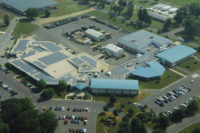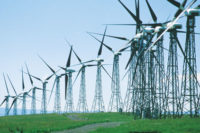Commercial Daylighting: Thermal Loss Vs. Electrical Energy Savings


Figure 1: Relative savings/losses from lighting and HVAC for a big box retail store in Phoenix. Source: U.S. Department of Energy, Building Technologies Program – “Commercial Building Toplighting: Energy Savings Potential and Potential Paths Forward.” Prepared by TIAX LLC. June 2008.

Figure 2: Annual primary energy savings by end use (lighting, cooling, and heating) as a function of SFR in Burlington, Vt.

Figure 3: Annual primary energy savings by end use (lighting, cooling, and heating) as a function of SFR in Phoenix.

Figure 4: Annual primary energy savings technical potential, by climate zone and building type. The source for the figures shown here is the U.S. Department of Energy, Building Technologies Program – “Commercial Building Toplighting: Energy Savings Potential and Potential Paths Forward.” Prepared by TIAX LLC. June 2008.





Daylighting is the use of natural light as a main illumination source from a myriad of glazing devices in both vertical and horizontal positions within a building. The use of daylighting stems from the beginning of time and since the beginning there have always been similar concerns regarding proper design, light output, glare and even heat. The quality of light and the value to the human eye and visual acuity have never been argued. The light in the shade of a tree has been measured at 600–800 foot candles (6,000 – 8,000 lux), yet the eye is never more relaxed than when it’s introduced to these lighting levels. It is the light that our eyes were made for. However, over time, the value of daylighting through a building’s roofing system (often referred to as “toplighting” in the United States) has taken on debate from an energy perspective, pitting thermal efficiency of a system against electric light energy reduction provided by the system. Today, code bodies are torn between thermal efficiency mandates and the use of commissioned lighting control with properly diffused, high visable light transmission skylights as to which properties provide the greatest performance measurements for total building energy efficiency. This article was written to discuss these differences and to expose the need for varying standards in systems based on the design and energy efficiency prescriptive used.
Thermal Performance and Energy Savings
In June 2008 the U.S. Department of Energy’s Building Technologies Program published a research paper titled “Commercial Building Toplighting: Energy Saving Potential and Potential Paths Forward,” which thoroughly investigated the energy savings benefits from toplighting systems in a multitude of climate conditions and locations throughout the United States. For this report, the U.S. DOE contracted with TIAX LLC that enlisted information and assistance from a breadth of respected lighting, controls and daylighting professionals around the country. The report was very thorough, looking into the multitude of reasons that building owners and operators of different functioning facilities should consider the use of skylights in conjunction with lighting control with a focus on total building energy savings and what the key factors were for a subsequent system.
What the DOE identified is really at the crux of the argument. If a skylighting system is being designed for use in a building absent of lighting control, then thermal performance value should be the highest consideration. After all, any thermal value (whether in thermal loss or thermal gain) that deviates negatively from that of the building envelope and roofing system will provide a negative energy impact to the building either in increased cooling loads or increased heating loads to the building. However, what would be the primary motivator for including less thermally efficient building products through a perfectly well insulated roofing system? One could argue that if thermal performance were the main motivator and only energy savings opportunity, an energy professional would argue that all toplighting products should be removed from the facility as they will never equal the insulated value of the roofing system.
However, globally you are now seeing mandates for thermal performance of toplighting systems rising with little to no mandate for performance around the light output properties let alone the key missing ingredient mandatory for any true energy savings through daylighting and that is commissioned lighting controls. In many cases around the world, what is happening is that building codes are being established with higher effective skylight-to-floor ratios to compensate for the reduced visible light transmission occurring from decreased values in solar heat gain (SHGC in United States or G-Value in Europe) as well as decreased conductance (U-value). For instance, the European Directive on the Energy Performance of Buildings—2002/91/EC under the 2006 Building Regulations Approved Document L2A — “Conservation of Fuel and Power in New Buildings other than Dwellings” — states that rooflights are limited to 20 percent of floor area and the area-weighted average U-value of all the rooflights must not exceed 2.2 W/m²K, while the U-value in an array must not exceed 3.3 W/m²K, providing the average U-value overall does not exceed 2.2 W/m²K. At these high skylight-to-floor ratios (SFRs) between 10 percent to 20 percent have shown, the increase to thermal mandates has driven the increase to SFRs to be able to meet light output needs for the space.
However, extensive studies have been performed on the value that lighting control mandates along with toplighting have done to minimize SFRs for a space, which decreases thermal impact and in many cases, even reduces air conditioning in the process. In section 4.6 of the U.S. DOE commercial toplighting report, it was found that the primary factors influencing the economics of toplighting are climate and building type (primarily due to lighting power density, schedule, and light well needs); appropriate skylight technology selection is also crucial. The key performance attributes of a skylight for daylighting are good diffusing properties to aid in light distribution and avoid glare and high visible transmittance (VT). Of special note in this report is that the DOE stated, “Other desirable properties that are much less important for daylighting applications are low solar-heat-gain coefficient (SHGC in U.S., G-Value in Europe Standards) and conductance (U-Value). The DOE report illustrates the rationale for this prioritization in a graph, re-created here as Figure 1.
The report also stated: “Reduced lighting energy use ranks as, by far, the greatest factor in the annual savings at economically optimum SFRs. The reduction in lighting energy use is directly related to VT, i.e. the higher the VT, the lower the total skylight area needed to achieve a given lighting energy savings. However total skylight area reduces cost and energy losses.” The report goes on to identify that, “To further minimize energy losses, in most climates, the SHGC and U-value of the skylight should be as low as possible. However, because heating and cooling energy losses are small relative to lighting energy savings, if reducing SHGC (G-value) or U-value results in any significant reduction in visible transmission (while maintaining high diffusion, 90%<), it is generally not a beneficial tradeoff at SFRs in the range expected to be economically optimal, i.e., below 5%.”
Going to Extremes
The report goes on to investigate this theory further by documenting the extreme climate conditions in the United States. The area with the lowest amount of solar load and highest heating degree figure in the United States was determined to be Burlington, Vt. The area with as the highest amount of solar load and highest cooling degree figure was determined to be Phoenix, Ariz. The report documented the results in total building energy savings from lighting, cooling and heating based on several building types and illustrated the findings in the report, re-created here as Figures 2 and 3.
What you will find Figures 2 and 3 is that light energy savings truly does compensate for any thermal loss or gain even in extreme climates and, in fact, is the main driving factor to any energy savings available for the space.
The U.S. DOE has proven that toplighting solutions that maximize visible light transmission with diffusion and the mandate for commissioned lighting control to maximize electric lighting reduction would produce 0.4 Quads of electricity reduction in the United States alone for buildings that should be daylighted. The report contained a chart showing the primary energy savings technical potential for buildings by climate zone, re-created here as Figure 4.
The DOE report suggested that code changes for big box retail and warehouse facilities could help expand daylighting opportunities and save energy. The report stated: “Codes limiting solar heat gain and U-value should be loosened for skylights used with lighting controls.” It also recommended codes requiring skylights in certain applications and that rating systems should be updated “to reflect performance in a toplighting application.”
As the DOE has documented, there is a major energy consumption difference in buildings that just implement skylights for visual affect and those that utilize commissioned lighting control to minimize the use of electric lighting during daylight hours. As noted above, codes limiting solar heat gain and U-value need to be loosened for applications where toplighting with lighting controls are utilized and commissioned properly. In the United States, building energy codes have even been established that mandate daylighting with lighting controls for certain building types. For instance in ASHRAE 90.1-2010, buildings over 10,000 square feet (929 square meters) with 15 foot (4.572 meters) or higher ceilings with a connected light load of 0.5 watts per square foot (5.38 watts per square meter) or greater have to utilize daylighting and commissioned lighting controls that are focused on high VT with diffusion with more relaxed requirements for U-Value and SHGC (G-value). The IECC 2012 code is also following this prescriptive as well.
As building energy codes evolve worldwide, the true energy savings benefits of passive solar lighting through daylighting and lighting controls are being discovered. The worldwide daylighting opportunity through reduced electric energy use of which 74 percent of all electricity usage is for buildings with 30 percent to 50 percent of this value being from electric lighting alone is staggering. Globally, the environmental impact through reduced carbon output is also as dramatic. The distinction to daylighting with lighting controls needs to be separated from the installation of skylights for aesthetics. The impact to the world would be both economically feasible as well as sustainable as a renewable energy solution harnessing the ultimate power of the sun. After all, there is no greater efficiency than “off.”
|
Insulation Values of Building Envelope Components The term “U-Value” may seem foreign to many in the roofing industry, as the usual measure for the insulation value of a product is described as “R-Value.” However, with skylights, U-Value is used to quantify heat loss through plane elements of the building envelope. U-value is defined as the overall thermal transmittance of a particular construction element (typically a window, door or skylight), including the effect of surface resistance. It depends upon the thickness and thermal conductivity of its component layers and, in the case of air cavities, the emissivity of the surfaces. As a measure of U-Value, the lower the number, the better the insulation value. Basically, U-Value is the converse of R-Value. There is an easy calculation that allows you to see what the R-Value of a window or skylight may be: 1 ÷ U-Value = R-Value Once you utilize this formula with different skylight systems, you will quickly realize that even some of the well-promoted thermally efficient skylights have a fraction of the R-Value that the building’s roofing system has. A skylight will never equal the insulation value of a roof and still allow for light to pass through it, so its only value is in the quality of light that passes through the product. After all, it is called a “skylight” not “sky-insulation.” |
Looking for a reprint of this article?
From high-res PDFs to custom plaques, order your copy today!











